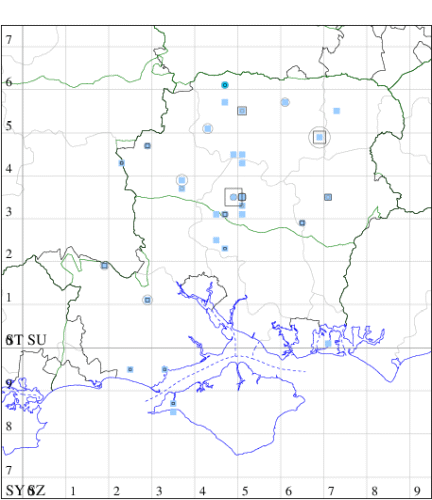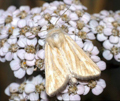Brighton Wainscot
Oria musculosa
Checklist Number73.143 [B&F: 2378]
Verification
Record will require further evidence, at least a good photograph, unless CMR is aware recorder has confidence in identification
Nationally scarce (Na) in corn fields in parts of southern England, a priority species under the UK Biodiversity Action Plan. The moth was
established in the Brighton area until around the end of the 19th century. During the 20th century, it was recorded over central southern and south-eastern England, though was probably resident only in central southern England. In Hampshire the species spread into wheatfields in the north of the county from its stronghold on Salisbury Plain around the time of the Second World War, and became locally common. It also turned up at times in southern Hampshire. However, after flourishing for several years, it underwent a spectacular crash in the late 1970s, and the last record was of one at Burghclere in 1983. The reasons for its sudden extinction in the county, and elsewhere, are not known. Not recorded from the Isle of Wight since 1952. In recent years Brighton Wainscot has been reported from just a single site on Salisbury Plain, Wiltshire.
The moth is primarily associated with the grassy margins beside cereal fields, the larvae feeding on the inner stems and seeds of wild grasses and cereal crops such as Winter Wheat, Summer Rye, Oats and Barley Poaceae. The species is single-brooded, with eggs laid on the foodplants in late summer, where they remain over the winter. The larvae hatch in late spring/early summer and feed in the stems of wild grasses before moving on to feed on cereals. Pupation takes place in a flimsy cocoon in the soil between June and July, with the adults flying at night from late July to mid August.
The moth is primarily associated with the grassy margins beside cereal fields, the larvae feeding on the inner stems and seeds of wild grasses and cereal crops such as Winter Wheat, Summer Rye, Oats and Barley Poaceae. The species is single-brooded, with eggs laid on the foodplants in late summer, where they remain over the winter. The larvae hatch in late spring/early summer and feed in the stems of wild grasses before moving on to feed on cereals. Pupation takes place in a flimsy cocoon in the soil between June and July, with the adults flying at night from late July to mid August.


The abundance in each month is indicated as follows:
 No records
No records Very occasional
Very occasional Irregular
Irregular Uncommon
Uncommon Off-peak, but not unusual
Off-peak, but not unusual Off-peak, but not unusual
Off-peak, but not unusual Main flight time
Main flight time| J | F | M | A | M | J | J | A | S | O | N | D | |
|---|---|---|---|---|---|---|---|---|---|---|---|---|
| Adult |  |  |  |  |  |  |  |  |  |  |  |  |
| Larval |  |  |  |  |  |  |  |  |  |  |  |  |


